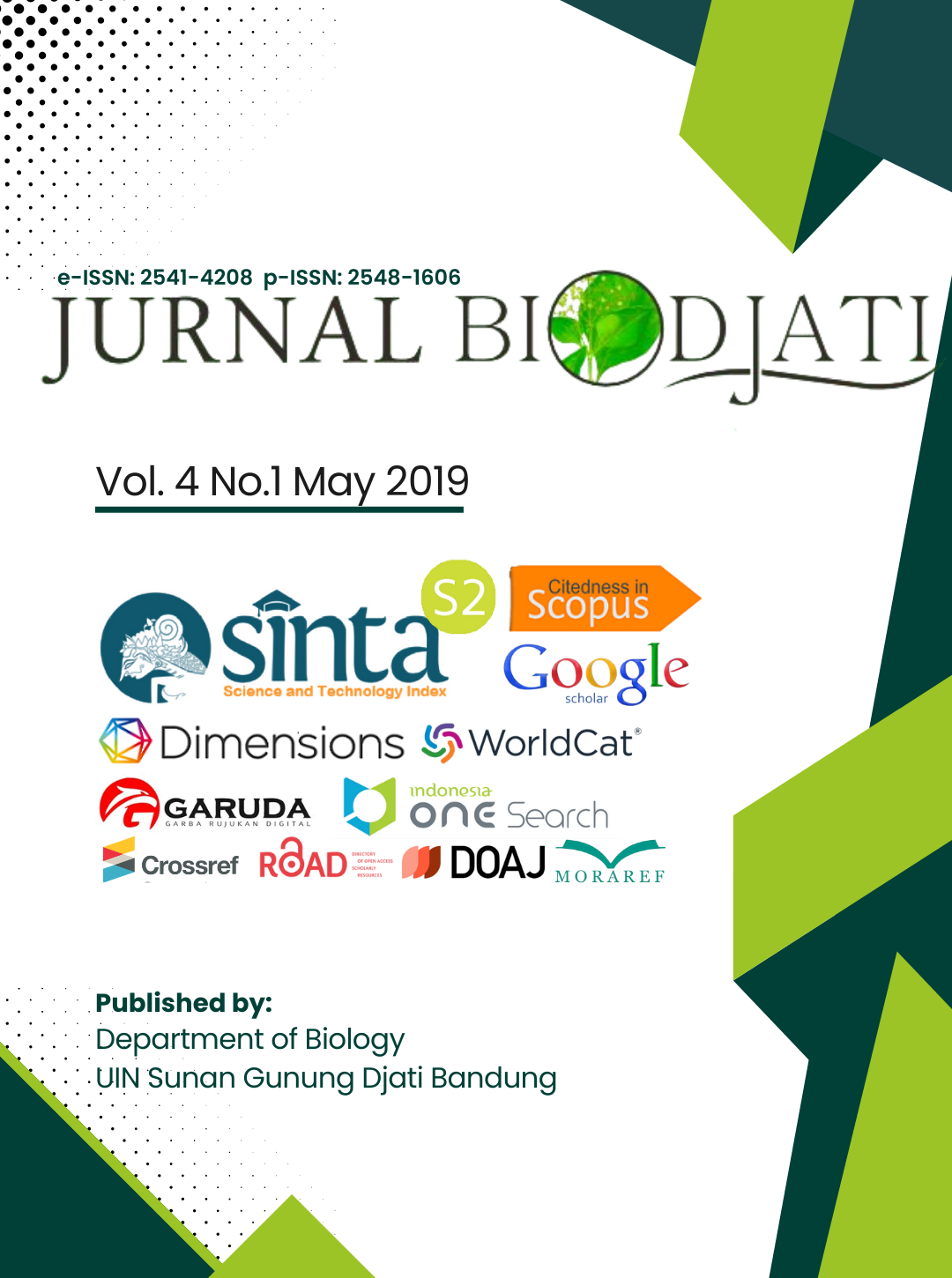Vegetation Analysis of the Secondary Forest Area of ​​Mount Merapi National Park
DOI:
https://doi.org/10.15575/biodjati.v4i1.4239Keywords:
diversity, Mount Merapi, national park, secondary forest, vegetationAbstract
 Mount Merapi National Park (MMNP) is a natural con-servation area with the main function of preserving the diversity of plants, animals and their ecosystems. In 2010, Mount Merapi suffered a large eruption which caused damage to the forest ecosystem inside. One of the locations that suffered severe damage was at Cangkrin-gan Resort. After the eruption, the affected vegetation began to grow again. The purpose of this study is to monitor and determine the di-versity of secondary forest plants in the MMNP area. The method used was a method of path and use a point-intercept transect as the sam-pling unit. The results showed that after the eruption, the Acacia de-curens dominated at each level starting from sapling, poles and trees. Based on the results of the study showed that the eruption of Mount Merapi that occurred in 2010 resulted in a change in vegetation struc-ture in the area with the Shannon-Weiner diversity index which is still low, amounting to 1.86 for seedling, 1.32 for the sapling and 0.22 for poles. At the tree level 100% is still dominated by Acacia decurens.
Â
References
Barbour, M. G., Burk, J. H. & Pitts, W. D. (1987). Terrestrial Plant Ecology (2nd ed). Menlo Park, Calif: Benjamin/Cum-mings Pub. Co.
Gibson, M. R., Richardson, D. M., Marchante, E., Marchante, H., Rodger, J. G., Stone, G. N. & Wilson, J. R. U. (2011). Repro-ductive Biology of Australian acacias: important mediator of invasiveness?: Reproductive biology of Australian aca-cias. Diversity and Distributions, 17(5), 911–933.
Gunawan, H., Sugiarti, Wardani, M., Tata, H. L. & Prajadinata, S. (2013). Restorasi Ekosistem Gunung Merapi Pasca Erup-si. Jakarta: Kementerian Kehutanan.
Heyne, K. (1987). Tumbuhan Berguna Indo-nesia. Jakarta: Departemen Kehutanan.
Indirasari, G. (2012). Identifikasi Tingkat Kerusakan Lahan Akibat Erupsi Mer-api Tahun 2010 Menggunakan Citra Penginderaan Jauh di Kecamatan Cang-kringan. Skripsi. Fakultas Ilmu Sosisal, Universitas Negeri Yogyakarta, Yogy-akarta.
Indriyanto. (2012). Ekologi Hutan. Jakarta: Bumi Aksara.
Marhaento, H. & Kurnia, A. N. (2015). Refl-eksi 5 Tahun Paska Erupsi Gunung Mer-api 2010: Menaksir Kerugian Ekologis di Kawasan Taman Nasional Gunung Metrap. Geoplanning: Journal of Geo-matics and Planning, 2(2).
Ministry of Environment and Forestry Re-public of Indonesia. (2018). The State of Indonesia’s Forests 2018. Jakarta: Ministry of Environment and Forestry Republic of Indonesia.
Nuryani, S., Darmanto, Jayadi, R., Martono, R., Benito, H., Kusumandari. & Kasno, D. (2011). Daya Dukung Lahan Kawa-san Lereng Merapi untuk Pertanian dan Peternakan Pasca Erupsi 2010. Prosid-ing Simposium Gunung Merapi, 95–99.
Panjaitan, S., Wahyuningtyas, R. S. & Am-barwati, D. (2011). Pengaruh Naungan terhadap Proses Ekofisiologi dan Per-tumbuhan Semai Shorea selanica (DC.) Blume di Persemaian. Jurnal Penelitian Dipterokarpa, 5(2), 73–82.
Steenis, C. G. G. van, Hamzah, A., Toha, M. & Kartawinata, J. A. (2006). Flo-ra Pegunungan Jawa: Dilengkapi 57 Gambar Berwarna Menampilkan 456 Spesies Tumbuhan Berbunga Asli Pe-gunungan Jawa, yang Dilukis dalam Ukuran Sebenarnya Berdasarkan Sp-esimen Hidup. Bogor; Jakarta, etc. Pu-sat Penelitian Biologi, Lembaga Ilmu Pengetahuan Indonesia (LIPI): LIPI Press.
Sundarapandian, S. & Swamy, P. S. (2000). Forest Ecosystem Structure and Com-position Along an Altitudinal Gradi-ent in The Western Ghats, Shout India. Journal of Tropical Forest Science, 12(1), 104–123.
Surono, Jousset, P., Pallister, J., Boichu, M., Buongiorno, M. F., Budisantoso, A. & Lavigne, F. (2012). The 2010 explosive eruption of Java’s Merapi volcano—A ‘100-year’ event. Journal of Volcan-ology and Geothermal Research, 241 (242), 121–135.
Surtikanti, H. K., Surakusumah, W., Safaria, T., Irawan, A. & Qadaryanti, A. (2016). Refleksi Fungsi Lahan Terhadap Bio-diversitas Tumbuhan di Daerah Aliran Sungai Cilaja, Ujung Berung. Jurnal Biodjati, 1(1), 59–65.
Suryana, S., Parikesit, P. P. & Iskandar, J. I. (2018). Struktur Vegetasi Kawasan Hutan pada Zona Ketinggian Berbeda di Kawasan Gunung Galunggung Ka-bupaten Tasikmalaya Jawa Barat. Jur-nal Ilmu Lingkungan, 16(2), 130.
Suryanto, P., Hamzah, M. Z., Mohamed, A. & Alias, M. A. (2010). The Dynamic Growth and Standing Stock of Acacia Decurrens Following the 2006 Eruption in Gunung Merapi National Park, Java, Indonesia. International Journal of Bi-ology, 2(2).
Suryawan, D. (2015). Sebaran invasive alien species Acacia decurrens pada kawasan Taman Nasional Gunung Merapi. Pre-sented at the Seminar Nasional Masyar-akat Biodiversitas Indonesia.
Susantyo, J. M. (2011). Inventarisasi Keane-karagaman Jenis Tumbuhan Di Kawa-san Taman Nasional Gunung Merapi Skripsi. Bogor: Institut Pertanian Bogor.
Downloads
Published
How to Cite
Issue
Section
Citation Check
License
Copyright and Attribution:
Copyright of published in Jurnal Biodjati is held by the journal under Creative Commons Attribution (CC-BY-NC-ND) copyright. The journal lets others distribute and copy the article, create extracts, abstracts, and other revised versions, adaptations or derivative works of or from an article (such as an tranlation), include in collective works (such as an anrhology), text or data mine the article, as long as they credit the author(s), do not represent the author as endorsing their adaptation of the article and do not modify the article in such a way as to damage the author's honor or reputation.
Permissions:
Authors wishing to include figures, tables, or text passages that have already been published elsewhere and by other authors are required to obtain permission from the copyright owner(s) for both the print and online format and to include evidence that such permission has been granted when submitting their papers. Any material received without such evidence will be assumed to originate of one of the authors.
Ethical matters:
Experiments with animals or involving human patients must have had prior approval from the appropriate ethics committee. A statement to this effect should be provided within the text at the appropriate place. Experiments involving plants or microorganisms taken from countries other than the authors own must have had the correct authorization for this exportation.



















